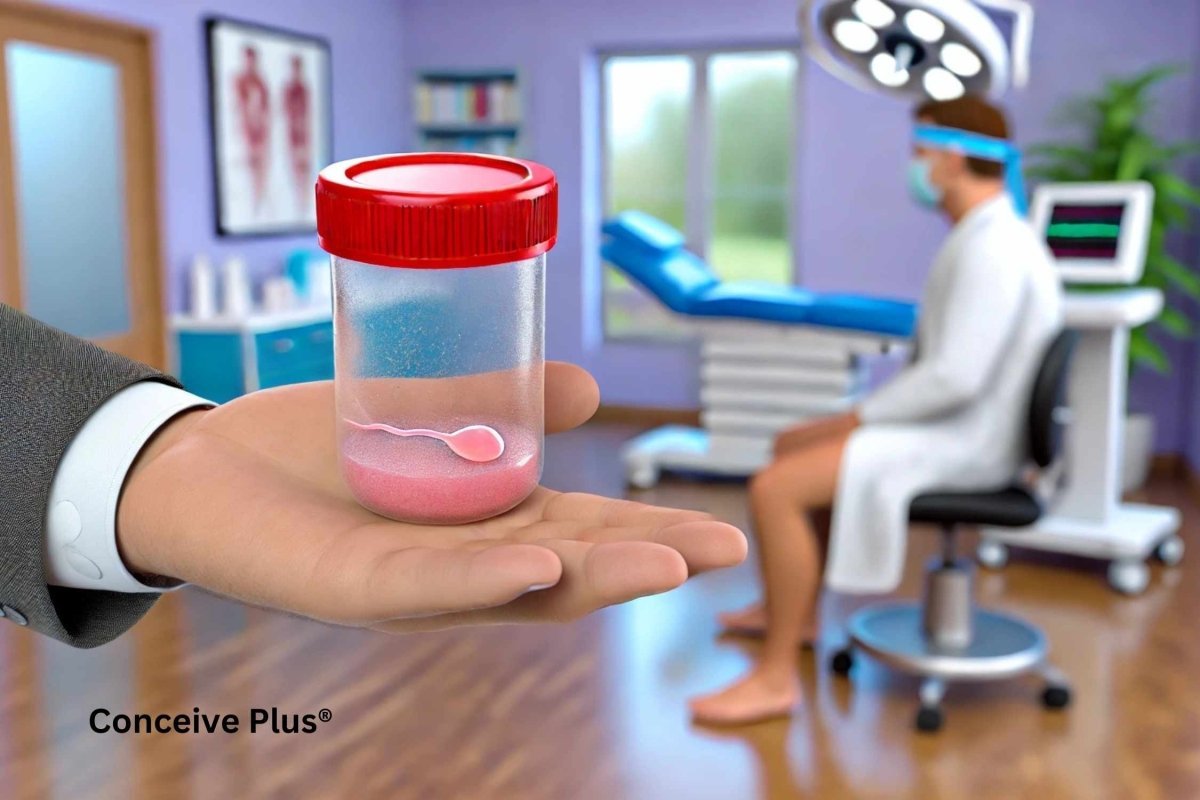Pink Colored Seman: Everything You Need To Know

A healthy semen has a whitish-grey color and it has a gel-like consistency [1]. Semen color can change once in a while for a variety of factors.
Occasional changes in semen color and consistency are usually not something to worry about. However, when these changes start to appear more frequently, it can be an indication of an issue with reprodutive health.
An example of a change in semen color is pink-colored semen. Pink cum occurs when there is blood in the semen. This can result from an infection of trauma in the male reproductive tract. This condition is called hematospermia [2].
In this article, we will explore the causes of pinkish-colored sperm and how to manage it. This article will also cover the sperm colour chart.
What is Normal Semen?
A normal semen of a healthy male is whitish-grey in color. It is a thick consistency, as of a gel. It can sometimes be slightly yellowish, which is usually considered normal.
Healthy semen also has a distinct odor, which some describe as mildly chlorine-like. After ejaculation, the gel-like consistency of semen changes into liquid within 15 to 30 minutes.
In contrast, unhealthy semen may appear discolored, such as pink, red, brown, or green, indicating potential health issues. A change in consistency, odor, or volume may also signal underlying problems.
What Does Pink Colored Semen Indicate?
Pink-colored semen usually means there’s blood mixed in, a condition called hematospermia. While it can be concerning, it’s often not a sign of something serious. Below are the four most common causes of pink-colored semen:
-
Prostate Issues
The prostate gland plays a key role in semen production. Inflammation or infection in the prostate (prostatitis) can cause blood to mix with semen, turning it pink [3]. It’s important to rule out prostate-related conditions, especially if accompanied by pain or urinary problems.
-
Infections
Infections in the reproductive system, such as sexually transmitted infections (STIs) or urinary tract infections (UTIs), can lead to inflammation and bleeding [4]. This can cause semen to take on a pink or reddish hue. Treating the infection usually clears up the problem.
-
Trauma or Injury
Physical injury to the reproductive organs, including the penis, cool testicles, or surrounding structures, can cause blood to appear in semen. Trauma from vigorous sexual activity or medical procedures like a prostate biopsy can also result in pink-colored semen.
-
Blocked Seminal Vesicles
The seminal vesicles produce a significant portion of semen. If they become blocked or damaged, it can lead to blood mixing with semen. In some cases, this blockage is related to benign cysts or other non-serious conditions.
What Do Brown Spots in Semen Indicate?
It is possible that someday you see brown particles in sperm or dark blood in semen. These particles are often old blood, which has had time to oxidize and change color [5].
The presence of brown spots in spem can be due to:
-
Old Bleeding
The most common reason for brown particles in semen is old bleeding. If you are worried that why is my cum red, it is quite likely that you had a past injury, infection, or inflammation. The blood turns brown and it develops red cum and sperm clots in this case.
-
Chronic Prostatitis
Chronic inflammation of the prostate can lead to once in a while bleeding, which may show up as brown particles in the semen.
-
Seminal Vesicle Issues
The seminal vesicles are responsible for producing a significant portion of the fluid in semen. Issues with these glands can lead to bleeding, which might present as brown particles.
What Is Semen Color Chart?
The semen color chart is a representation of different possible colors of the semen [6]. It tells what each color means for male reprodutive health.
Here are some commonly observed colors from the sperm color chart:
- White or Grayish: This is the typical color of healthy semen in the sperm chart and it is used as a reference. It’s usually thick and cloudy, with a consistency that changes from gel-like to more liquid over time.
- Yellowish: A slight yellow tint is usually not a cause for concern and can result from mixing with urine. However, a strong yellow color of semen is among the symptoms of sperm infection. In the majority of cases, it is because of the presence of urine in the semen [7].
- Pink or Red: Sperm red or pinkish seamen is likely due to the presence of blood (hematospermia). Pink ejaculate or pink semen could result from infections, inflammation, or trauma to the reproductive system.
- Brown or Rust-colored: Brown spots in sperm or rust-colored semen usually indicate old blood, possibly from a previous injury or infection. It’s important to get checked if this persists.
- Green: Greenish semen may point to an infection, particularly one involving the prostate or reproductive organs, and it should be addressed by a healthcare professional.
When to See a Doctor
While occasional changes in semen color may not be cause for concern, persistent changes should be evaluated by a healthcare professional. Here are some signs that indicate it’s time to see a doctor:
- Persistent pink or red semen for more than a few days.
- Accompanied symptoms such as pain, fever, or difficulty urinating.
- Presence of brown particles consistently.
- Any other worrying symptoms like unexplained weight loss or severe pain.
Diagnostic Tests
Based on the initial evaluation, your doctor may recommend some diagnostic tests, including:
- Urinalysis: To check for infections or blood in the urine.
- Semen Analysis: To examine the semen for blood cells and other abnormalities. Search Semen Analysis near me.
- Ultrasound: To visualize the reproductive organs and check for obstructions or growths.
- Blood Tests: To evaluate overall health and rule out systemic conditions.
Treatment Options For Pink Colored Semen
The treatment for pink or any colored semen will vary based on the root cause. It’s important to consult with a healthcare professional to identify the specific cause and choose the best course of treatment.
Here are some common treatments:
- Antibiotics: If an infection is responsible for the blood in the semen, antibiotics may be prescribed to clear up bacterial infections, such as urinary tract infections or sexually transmitted infections.
- Anti-inflammatory Medications: In cases of inflammation, like prostatitis, anti-inflammatory medications can help reduce swelling and discomfort, often resolving the issue of blood in the semen.
- Surgery: If the cause is an obstruction, cyst, or any abnormal growth within the reproductive system, surgical intervention may be necessary to correct the issue and prevent further blood from appearing in the semen.
- Lifestyle Changes: Simple lifestyle changes such as drinking more water, eating a balanced diet, and avoiding trauma to the reproductive organs can help. These changes may not directly treat the condition but can prevent it from getting worse or reoccurring.
Key Takeaways About Pink Colored Semen
Changes in semen color, including the presence of pink or brown particles, can be concerning but are often due to temporary and treatable conditions.
Information about the potential causes and knowing when to seek medical advice can help you maintain your reproductive health. If you notice persistent or severe changes, consult with a healthcare professional for a thorough evaluation and appropriate treatment.
FAQs
-
Why is my cum pink?
Pinkish seminal fluid or pink sperm in ejaculation is apparently a sign of the presence of blood. The common causes of blood in semen are infection and trauma.
-
Why is my semen red?
Red semen indicates old bleeding in the reproductive tract of a male. You may also see reddish semen in conditions such as chronic prostatitis.
-
Discharge what color is dry sperm?
Sperm dries after a few minutes of ejaculation and a dry sperm usually appears as white or slightly yellow.
Resources Used
- Discolored semen: What does it mean? (2022, November 29). Mayo Clinic. https://www.mayoclinic.org/discolored-semen/expert-answers/faq-20058363
- Mathers, M. J., Degener, S., Sperling, H., & Roth, S. (2017). Hematospermia—A Symptom With Many Possible Causes. Deutsches ÄRzteblatt International, 114(11), 186-191. https://doi.org/10.3238/arztebl.2017.0186
- Maeda, K., Shigemura, K., & Fujisawa, M. (2023). A review of current treatments for chronic prostatitis/chronic pelvic pain syndrome under the UPOINTS system. International Journal of Urology, 30(5), 431-436. https://doi.org/10.1111/iju.15149
- Teixeira, T. A., Oliveira, Y. C., Bernardes, F. S., Kallas, E. G., Duarte-Neto, A. N., Esteves, S. C., Drevet, J. R., & Hallak, J. (2021). Viral infections and implications for male reproductive health. Asian Journal of Andrology, 23(4), 335-347. https://doi.org/10.4103/aja.aja_82_20
- Professional, C. C. M. (2024a, May 1). Blood in Semen (Hematospermia). Cleveland Clinic. https://my.clevelandclinic.org/health/symptoms/blood-in-semen-hematospermia
- Understanding the Normal Sperm Color Chart. Conceive Plus®. https://conceiveplus.com/blogs/blog/normal-sperm-color-chart
- Ellerbrock, R., Canisso, I., Feijo, L., Lima, F., Shipley, C., & Kline, K. (2016). Diagnosis and effects of urine contamination in cooled-extended stallion semen. Theriogenology, 85(7), 1219-1224. https://doi.org/10.1016/j.theriogenology.2015.12.002
Buy sperm count supplements for the best products to increase sperm count for men. Shop natural sperm count enhancers and quality vitamins to improve sperm count. Conceive Plus Men's Fertility products are the best products to increase sperm count and sperm volume - trusted by Doctors and fertility experts since 2008!













